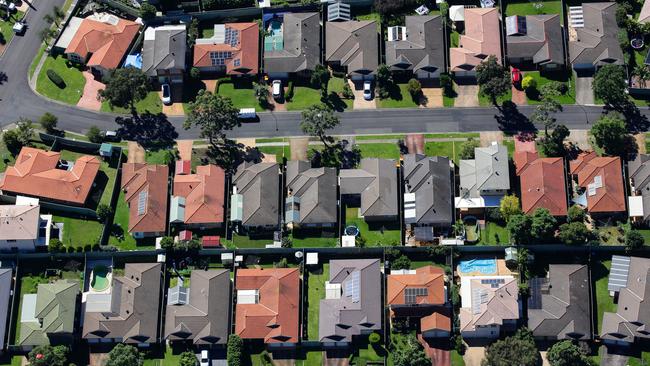
It is a far call from the more aggressive “macroprudential” lending controls it imposed in 2014 and 2015, when APRA was concerned about investor borrowing and the banks making interest-only loans.
This week’s move will hit investors – who have been coming back into the housing market lately – and would-be borrowers on the lowest incomes levels.
But better-off Australians should still be able to cope with the new requirement on banks to assume a 0.5 percentage-point higher possible mortgage rate when assessing individual borrowers’ capacity to repay.
Housing prices have risen by a staggering 20-25 per cent this year already, the fastest annual growth rate in more than 30 years.
Announcing the move, APRA said it expected the 50-basis-point increase in the “serviceability buffer”, from 2.5 per cent above the home loan rate to 3 per cent, would reduce the maximum borrowing capacity for a typical borrower by about 5 per cent.
But the move will not hit all borrowers, with many people allowing comfortable buffers anyway when evaluating their home loan repayment capacity.
APRA itself said on Wednesday that it expected the “overall impact on aggregate housing credit growth flowing from this is expected to be fairly modest”.
Taking the first cautious step, APRA has hinted that if the home lending market doesn’t cool down enough, more measures may be ahead, including controls on debt-servicing ratios.
The statement points out that more than 20 per cent of new lending by approved deposit institutions in the June quarter (a record 22 per cent) was to people who had borrowed more than six times their pre-tax annual income — up from 14.6 per cent in the June quarter of 2019.
Imposing controls on loan-to-income ratios over this level could be a new potential area of APRA action.
Home loan borrowers in Australia have been given a sense of confidence – some might say overconfidence – by being regularly reassured by the Reserve Bank, month after month, that the bank would not be lifting its cash rate from its current record low of 10 basis points until 2024.
The constant statements about its intentions of not moving the cash rate during the pandemic are unprecedented – designed to provide a floor of confidence under the economy, which could be a lot more fragile than it appears in the wake of months of lockdowns and closed domestic and international borders.
This week’s move by APRA – which was made in full support of all the financial regulators, including the RBA – takes the pressure off the central bank to lift its cash rate to prick the home price bubble.
But with housing prices in major cities skyrocketing for most of the year, the question is why APRA waited so long to move.
The more cynical might say that regulators have been staying out of the market, reluctant to clamp down too much ahead of the federal election due by May 21 next year.
While skyrocketing prices add to income inequality – causing increasing resentment by those on low incomes, and dispirited younger would-be home buyers who feel increasingly locked out of the market – they make those who do own property feel a lot better off, enjoying the feel-good wealth effect of knowing their home is worth a lot more than what they paid for it.
The higher the value of your home, the more likely you are to spend up once lockdowns end.
A cynic might also say that it took strong comments on the overheated housing market in Australia by observers such as the International Monetary Fund and the OECD before APRA decided to act.
Or maybe the housing market – and concern over rising household debt levels – just got to a tipping point where they were just too hot to handle, and APRA had to act.
The timing may well have been dictated by the announcement this week, which comes ahead of the RBA’s six-monthly financial stability review on Friday that is expected to devote some space to the home-loan and household debt situation.
The main reason behind the move is not to put a lid on the increasing income inequality that is taking place due to housing price rises – which is a long-term worry for Australian society, setting off young people against property owning “boomers”.
It is the concern at the overall risks to the economy and the financial system of increasing household debt levels.
In a statement released on September 29, the Council of Financial Regulators (the Reserve Bank, APRA and the Australian Securities & Investments Commission) reported that it was “mindful that a period of credit growth materially outpacing growth in household income would add to the medium-term risks facing the economy”. But the council was quick to add that bank lending standards in Australia remained “sound”.
The best insight into the RBA’s thinking can be found in a speech given on September 22 by the bank’s assistant governor (financial system) Michele Bullock, who oversees the preparation of the financial stability review.
When the pandemic stuck Australia early last year, the big worry was that housing prices would collapse as the jobless rate rose and the economy fell into a potential recession.
Eighteen months later, Bullock points out in the speech, the concern is not the fallout from falling property prices, but the “surprising and dramatic rebound in the housing market”, which was raising the question of “whether there are financial stability risks from these developments and the accompanying housing credit”.
If the current trends continued, she said, housing credit growth could rise from its current annualised rate of 7 per cent a year to as much as 11 per cent next year.
As she pointed out, “the strength in the housing market is positive for the economy and indeed an important channel for monetary policy to support the economy through housing construction, home improvements and purchases of household items”.
But she warned that “while household debt to income in Australia hasn’t increased much over recent years, it is at a high level, both historically and relatively to other countries”.
“Sustained strong growth in credit in excess of income growth may result in vulnerabilities in bank and household balance sheets,” she added.
One wonders why APRA took such a high-profile move, which represented more of a signal than a regulatory clampdown.
The aim is to calmly manage expectations down – gently tapping the brakes, rather than slamming them on and leading to a broader loss of confidence.
But with housing prices continuing to soar, despite the pandemic, more action from APRA will most likely be necessary.








When it comes to cooling the overheated housing market in the nation’s capital cities, Wednesday’s moves by the Australian Prudential Regulation Authority represent a gentle tapping of the brakes.